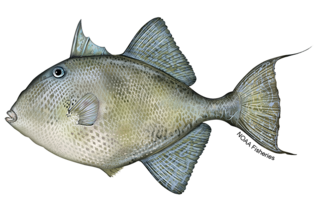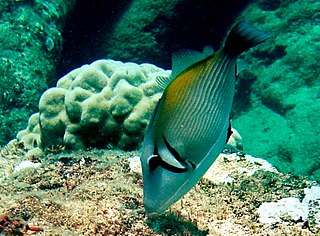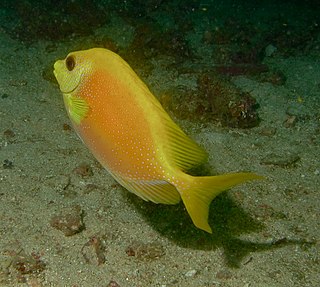
Triggerfish are about 40 species of often brightly colored fish of the family Balistidae. Often marked by lines and spots, they inhabit tropical and subtropical oceans throughout the world, with the greatest species richness in the Indo-Pacific. Most are found in relatively shallow, coastal habitats, especially at coral reefs, but a few, such as the oceanic triggerfish, are pelagic. While several species from this family are popular in the marine aquarium trade, they are often notoriously ill-tempered.

The clown triggerfish, also known as the bigspotted triggerfish, is a demersal marine fish belonging to the family Balistidae, or commonly called triggerfish.

The Redtoothed triggerfish is a triggerfish of the tropical Indo-Pacific area, and the sole member of its genus. Some other common names include blue triggerfish, redfang triggerfish, redtoothed filefish, and Niger triggerfish.

Pseudobalistes fuscus is a fish belonging to the family Balistidae.

The titan triggerfish, giant triggerfish or moustache triggerfish is a large species of triggerfish found in lagoons and at reefs to depths of 50 m (160 ft) in most of the Indo-Pacific, though it is absent from Hawaii. With a length of up to 75 centimetres (30 in), it is the largest species of triggerfish in its range.

The loggerhead sea turtle is a species of oceanic turtle distributed throughout the world. It is a marine reptile, belonging to the family Cheloniidae. The average loggerhead measures around 90 cm (35 in) in carapace length when fully grown. The adult loggerhead sea turtle weighs approximately 135 kg (298 lb), with the largest specimens weighing in at more than 450 kg (1,000 lb). The skin ranges from yellow to brown in color, and the shell is typically reddish brown. No external differences in sex are seen until the turtle becomes an adult, the most obvious difference being the adult males have thicker tails and shorter plastrons than the females.

Melichthys is a small genus in the triggerfish family (Balistidae). Member species are found in the Indian Ocean, Pacific Ocean and even the Red Sea. The Black triggerfish is the largest species in this genus at 45 cm in length and the Indian triggerfish is the smallest at 25 cm. Melichthys niger and Melichthys indicus are similar in appearance and are often confused.

The green sea turtle, also known as the green turtle, black (sea) turtle or Pacific green turtle, is a species of large sea turtle of the family Cheloniidae. It is the only species in the genus Chelonia. Its range extends throughout tropical and subtropical seas around the world, with two distinct populations in the Atlantic and Pacific Oceans, but it is also found in the Indian Ocean. The common name refers to the usually green fat found beneath its carapace, not to the color of its carapace, which is olive to black.

The orange-lined triggerfish is a demersal triggerfish. Although Balistapus is a monotypic genus, it is closely related to the genus Balistoides.

The grey triggerfish, or gray triggerfish, is a species of ray-finned fish in the triggerfish family. The species is native to shallow parts of the western Atlantic from Nova Scotia to Argentina and also the eastern Atlantic, the Mediterranean Sea and off Angola on the west coast of Africa.

Cantherhines dumerilii is a species of fish in the family Monacanthidae, the filefishes. Its common names include whitespotted filefish, barred filefish, orange-fin file, and yelloweye leatherjacket. It is distributed in the Indian and Pacific Oceans where it is found on coral reefs.

The blackbelly triggerfish is a ray-finned fish in the family Balistidae found in the Indo-Pacific. It occasionally makes its way into the aquarium trade. It is sometimes known as the blackpatch triggerfish.

Sufflamen bursa the Lei Triggerfish is also known as the bursa triggerfish, scythe triggerfish or boomerang triggerfish, is a triggerfish from the Indo-Pacific. Its name is derived from the two markings behind its eyes that wrap around the fish similar to a Hawaiian Lei. The color of these markings changes depending on the fish's mood, in which case the colors may alter from yellow, dark brown, and black. It is a species of reef fish found in reef ecosystems in the Indo-Pacific, including Japan, Australia, and Hawaii. It occasionally makes its way into the aquarium trade.

Canthidermis is a genus of triggerfishes commonly known as ocean triggerfishes.

The blue-spotted spinefoot, the coral rabbitfish, coral spinefoot, ocellated spinefoot or orange spinefoot, is a species of marine ray-finned fish, a rabbitfish belonging to the family Siganidae. It is found in the Indo-Pacific where it is often caught as a food fish and occasionally as an aquarium fish.

Stephanolepis cirrhifer, commonly known as the thread-sail filefish, is a species of marine fish in the family Monacanthidae. It is found in the western Pacific, in an area that ranges from northern Japan to the East China Sea, to Korea. Other common names for the fish include kawahagi (カワハギ,皮剥) (Japanese) and “쥐치” "Jwi-chi" (Korean). The fish grows to a maximum length of about 12 inches, and consumes both plant material and small marine organisms like skeleton shrimp. S. cirrhifer is host of the parasite Peniculus minuticaudae. Some minor genetic differentiation between S. cirrhifer born in the wild and those bred in a hatchery for consumer use has been shown. The fish is edible and sold commercially for culinary purposes in many Asian countries.

Chilomycterus reticulatus, the spotfin burrfish, spotted burrfish, Pacific burrfish, spotfin porcupinefish or few-spined porcupinefish, is a species of fish in the genus Chilomycterus, which is part of the porcupinefish family Diodontidae.

Lethrinus lentjan is a species of emperor fish. It has a distinctive blood-red colouration around the margin of the gill covers. It is widespread around the Indo-West Pacific, and is reef-associated. This species is fished commercially and for sport.

Abalistes filamentosus is a triggerfish of the genus Abalistes. It is found in the Indo-Pacific Ocean and in subtropical waters. It lives in the Pelagic-Neritic zone of the ocean between 61–180 meters deep. It is harmless to humans.
Rhinecanthus lunula, commonly known as the halfmoon picassofish, is a species of balistid triggerfish first described by John E. Randall and Roger C. Steene in 1983. It belongs to the Indo-Pacific triggerfish genus Rhinecanthus.




















